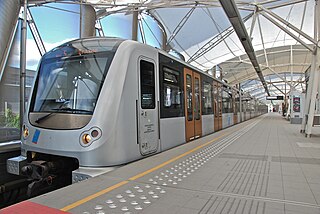
The Brussels Metro is a rapid transit system serving a large part of the Brussels-Capital Region of Belgium. It consists of four conventional metro lines and three premetro lines. The metro-grade lines are M1, M2, M5, and M6 with some shared sections, covering a total of 39.9 kilometres (24.8 mi), with 59 metro-only stations. The premetro network consists of three tram lines that partly travel over underground sections that were intended to be eventually converted into metro lines. Underground stations in the premetro network use the same design as metro stations. A few short underground tramway sections exist, so there is a total of 52.0 kilometres (32.3 mi) of underground metro and tram network. There are a total of 69 metro and premetro stations as of 2011.

Arts-Loi (French) or Kunst-Wet (Dutch) is a Brussels Metro station on lines 1, 2, 5 and 6. It is located in the City of Brussels, Belgium, under the intersection of the Rue de la Loi/Wetstraat and the Avenue des Arts/Kunstlaan, after which it is named, the latter street being part of the Small Ring.

Simonis and Elisabeth are two interconnected Brussels Metro stations serving lines 2 and 6 on two different levels, as well as a tram and bus stop. Additionally, Simonis railway station is a railway station operated by the National Railway Company of Belgium (SNCB/NMBS). It is served by the Brussels Regional Express Network (RER/GEN) service.

Osseghem or Ossegem is a Brussels Metro station on lines 2 and 6. It is located under the Chaussée de Gand/Gentse Steenweg in the municipality of Molenbeek-Saint-Jean, in the western part of Brussels, Belgium. The station takes its name from the nearby Osseghem/Ossegem neighbourhood.

Beekkant is a Brussels Metro station on lines 1, 2, 5 and 6. It is located under the Boulevard Edmond Machtens/Edmond Machtenslaan in the municipality of Molenbeek-Saint-Jean, in the western part of Brussels, Belgium. The station's name translates into English as "Brookside".
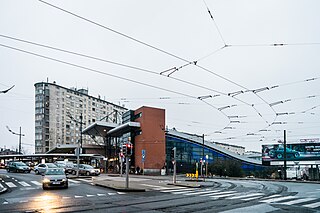
Brussels-West Station is a multimodal transport hub located in the municipality of Molenbeek-Saint-Jean, in the western part of Brussels, Belgium. It mainly consists of Gare de l'Ouest (French) or Weststation (Dutch), a Brussels Metro station on lines 1, 2, 5 and 6, as well as a tram and bus stop. Additionally, Brussels-West railway station is a railway station operated by the National Railway Company of Belgium (SNCB/NMBS). It is served by the Brussels Regional Express Network (RER/GEN) service.

Porte de Hal or Hallepoort (Dutch) is a rapid transit station in Brussels, Belgium, consisting of both a metro station and a premetro station. The station is located in the municipality of Saint-Gilles, south of the City of Brussels, under the Small Ring and next to the 14th-century Halle Gate, after which it is named. It is one metro stop away or about ten minutes' walk from Brussels-South railway station.
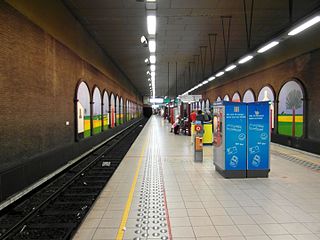
Clemenceau is a Brussels Metro station on the southern segment of lines 2 and 6. It is located under the Rue Jorez/Jorezstraat, close to the Avenue Clemenceau/Clemenceaulaan, in the municipality of Anderlecht, in the western part of Brussels, Belgium. The station takes its name from that nearby avenue, itself named after Georges Clemenceau, a former Prime Minister of France.

Delacroix is a Brussels Metro station on lines 2 and 6. It is located in the municipality of Anderlecht, in the western part of Brussels, Belgium. It is an elevated station, running parallel to the Rue Léon Delacroix/Léon Delacroixstraat, and forming a bridge-viaduct over the Brussels–Charleroi Canal, with entries and exits leading to and from both banks of the canal. The station takes its name from that nearby street, itself named after Léon Delacroix, Belgium's 22nd Prime Minister.

Hôtel des Monnaies (French) or Munthof (Dutch) is a Brussels Metro station on the southern segment of lines 2 and 6. It is located under the Small Ring, near Saint Peter's Hospital, in the municipality of Saint-Gilles, south of the City of Brussels, Belgium. One of its entrances is on the Rue de l'Hôtel des Monnaies/Munthofstraat, after which it is named, and where Belgian currency used to be minted.
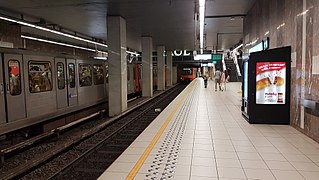
Louise (French) or Louiza (Dutch) is a Brussels Metro station on the southern segment of lines 2 and 6. It is located under the Small Ring at the Place Louise/Louizaplein, at the end of Avenue Louise/Louizalaan, in the City of Brussels, Belgium. The station takes its name from that nearby avenue, itself named after King Leopold II's eldest daughter, Princess Louise.

Porte de Namur or Naamsepoort (Dutch) is a Brussels Metro station on the southern segment of lines 2 and 6. It is located under the Small Ring at the Square du Bastion/Bolwerksquare, next to the Chaussée d'Ixelles/Elsense Steenweg, in the municipality of Ixelles, south of the City of Brussels, Belgium. The station takes its name from the Namur Gate area, itself named after the Namur Gate in Brussels' old city walls.
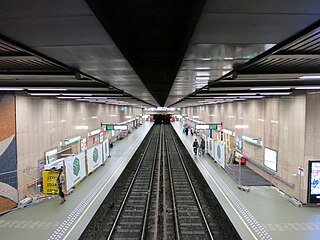
Trône (French) or Troon (Dutch) is a Brussels Metro station on the southern segment of lines 2 and 6. It is located under the Small Ring at the Place du Trône/Troonplein, near the Royal Palace, in the City of Brussels, Belgium.
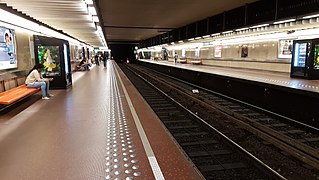
Madou is a Brussels Metro station on the northern segment of lines 2 and 6. It is located under the Small Ring at the Place Madou/Madouplein, next to Madou Plaza Tower, in the municipality of the Saint-Josse-ten-Noode, north of the City of Brussels, Belgium. The station takes its name from that aboveground square, itself named after the painter and lithographer Jean-Baptiste Madou.

Botanique (French) or Kruidtuin (Dutch) is a Brussels Metro station on the northern segment of lines 2 and 6. It is located under the Small Ring at the Rue Royale/Koningsstraat in the municipality of the Saint-Josse-ten-Noode, north of the City of Brussels, Belgium.

Rogier is a rapid transit station in Brussels, Belgium, consisting of both a metro station and a premetro station. It is located under the Small Ring at the Place Charles Rogier/Karel Rogierplein in the municipality of the Saint-Josse-ten-Noode, north of the City of Brussels. The station takes its name from that aboveground square, itself named after Charles Rogier, Belgium's 13th Prime Minister.
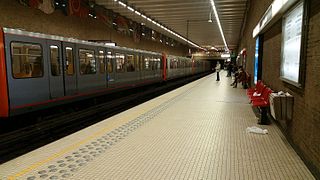
Ribaucourt is a Brussels Metro station on the northern segment of lines 2 and 6. It is located under the Boulevard Léopold II/Leopold II-laan in the municipality of Molenbeek-Saint-Jean, in the western part of Brussels, Belgium. The station takes its name from the Belgian noble family De Ribaucourt, as well as De Ribaucourt park and castle.

Line 2 is a rapid transit line on the Brussels Metro in Belgium operated by STIB/MIVB. It has existed in its current form since 4 April 2009, when the section between Delacroix and Gare de l'Ouest/Weststation was opened, which allowed to close the "loop" from and to Simonis/Elisabeth. The configuration of Simonis/Elisabeth though does not allow trains on line 2 to perform the loop several consecutive times in the same direction, i.e. a train running clockwise from Elisabeth will have to run counterclockwise from Simonis. The two termini of line 2 have thus received different names: originally Simonis (Elisabeth) and Simonis , changed in November 2013 to Elisabeth and Simonis. Between Yser/IJzer and the Porte de Hal/Hallepoort, the line runs under the Small Ring, which was itself built on the site of the former second walls of Brussels. The line crosses the municipalities of Koekelberg, Molenbeek-Saint-Jean, City of Brussels, Saint-Gilles and Anderlecht.
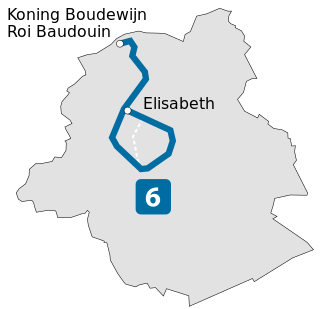
Line 6 is a rapid transit line on the Brussels Metro in Belgium operated by STIB/MIVB. It connects Roi Baudouin/Koning Boudewijn in the north-west of Brussels to Simonis/Elisabeth to the north-west of the city centre, then performing a counterclockwise "loop" around the centre up to Simonis again. During this loop, the line runs under the Small Ring, from Porte de Hal/Hallepoort to Yser/IJzer. It has existed in its current form since 4 April 2009, when it replaced former line 1A between Roi Baudouin and Beekkant. It serves 25 metro stations and has 26 stops, metros on that line stopping twice at Simonis. The Simonis-Elisabeth loop is also served by line 2. The line has also a common section with lines 1 and line 5 between Gare de l'Ouest/Weststation and Beekkant. A connection with those lines is also possible at Arts-Loi/Kunst-Wet. Starting from Roi Baudouin, the line crosses the municipalities of the City of Brussels, Jette, Koekelberg, Molenbeek-Saint-Jean, Anderlecht and Saint-Gilles.
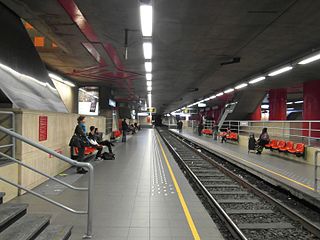
Gare du Midi (French) or Zuidstation (Dutch) is a rapid transit station in Brussels, Belgium, consisting of both a metro station and a premetro station.




















